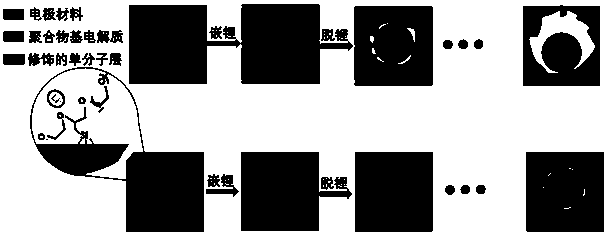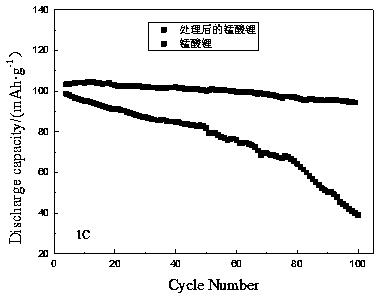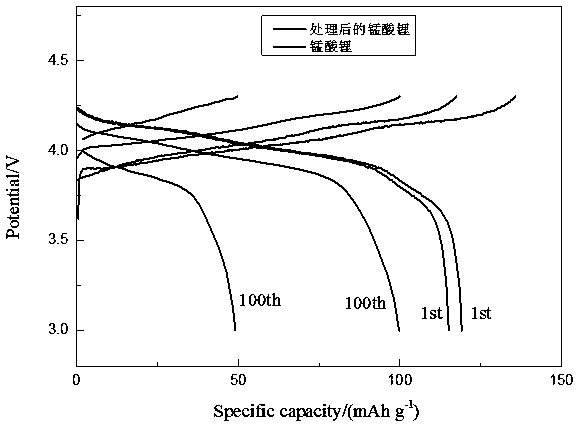A method for modifying the surface of battery positive electrode materials by using a coupling agent
A battery positive electrode and electrode material technology, applied in battery electrodes, positive electrodes, secondary batteries, etc., to achieve the effect of improving cycle stability and excellent performance
- Summary
- Abstract
- Description
- Claims
- Application Information
AI Technical Summary
Problems solved by technology
Method used
Image
Examples
Embodiment 1
[0028] This embodiment provides a method for modifying the surface of the positive electrode material of the battery using a coupling agent, such as figure 1 As shown, the method steps are as follows:
[0029] 1. Weigh lithium manganese oxide (LiMn 2 o 4 ) material, put it into a vacuum drying oven for drying treatment.
[0030] 2. Completely dissolve 20g of dry lithium manganate in 30% H 2 o 2 In the aqueous solution, it was refluxed and extracted at 106° C. after standing for 20 minutes.
[0031] 3. Dissolve 5g of γ-(2,3-propylene oxide)propyltrimethoxysilane in 60mL of water-ethanol mixture, stir evenly, and add the lithium manganate material prepared in step 2 to make the two After extensive contact for 3 h, the solution was filtered and dried, and the material was vacuum dried at 80 °C for 12 h.
[0032] 4. Weigh 2.5g of polyoxyethylene and dissolve it in anhydrous acetonitrile, then add 0.9g of LiN(CF 3 SO 3 ) 2 After mixing, stir for 12 hours, and then disperse...
Embodiment 2
[0035] This embodiment provides a method for modifying the surface of the positive electrode material of the battery using a coupling agent, such as figure 1 As shown, the method steps are as follows:
[0036] 1. Weigh lithium cobalt oxide (LiCoO 2 ) material, put it into a vacuum drying oven for drying treatment.
[0037] 2. Completely dissolve 20g of dry lithium cobaltate in 30% H 2 o 2 In the aqueous solution, it was refluxed and extracted at 106° C. after standing for 20 minutes.
[0038] 3. Dissolve 5g of γ-aminopropyltriethoxysilane in 60mL of water-ethanol mixture, stir evenly, and add the lithium cobaltate material prepared in step 2. After the two are fully contacted for 3 hours, the solution After drying by filtration, the material was vacuum dried at 80 °C for 12 hours.
[0039] 4. Weigh 2.5g of polyacrylonitrile and dissolve it in acetone, then add 0.9g of LiPF to it 6After mixing, stir for 12 hours, and then disperse the material obtained in Step 3 and 2.5 g...
Embodiment 3
[0041] This embodiment provides a method for modifying the surface of the positive electrode material of the battery using a coupling agent, such as figure 1 As shown, the method steps are as follows:
[0042] 1. Weigh lithium nickel manganese oxide (LiNi 0.5 mn 1.5 o 4 ) material, put it into a vacuum drying oven for drying treatment.
[0043] 2. Completely dissolve 20g of dried lithium nickel manganese oxide in 30% H 2 o 2 In the aqueous solution, it was refluxed and extracted at 106° C. after standing for 20 minutes.
[0044] 3. Dissolve 5g of γ-aminopropyltriethoxysilane in 60mL of water-ethanol mixture, stir evenly, and add the lithium nickel manganese oxide material prepared in step 2. After the two are fully contacted for 3 hours, put The solution was dried by filtration and the material was dried under vacuum at 80°C for 12 hours.
[0045] 4. Weigh 2.5g of polymethyl methacrylate and dissolve it in acetone, then add 0.9g of LiPF to it 6 After mixing, stir for 1...
PUM
| Property | Measurement | Unit |
|---|---|---|
| quality score | aaaaa | aaaaa |
Abstract
Description
Claims
Application Information
 Login to View More
Login to View More - R&D
- Intellectual Property
- Life Sciences
- Materials
- Tech Scout
- Unparalleled Data Quality
- Higher Quality Content
- 60% Fewer Hallucinations
Browse by: Latest US Patents, China's latest patents, Technical Efficacy Thesaurus, Application Domain, Technology Topic, Popular Technical Reports.
© 2025 PatSnap. All rights reserved.Legal|Privacy policy|Modern Slavery Act Transparency Statement|Sitemap|About US| Contact US: help@patsnap.com



